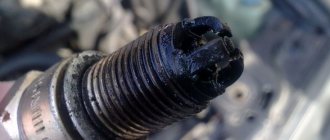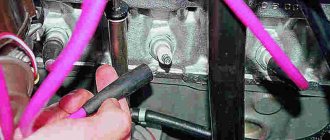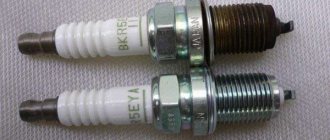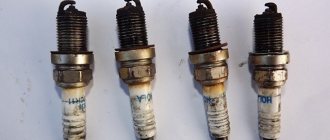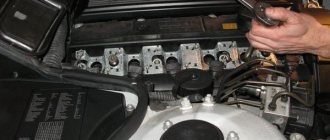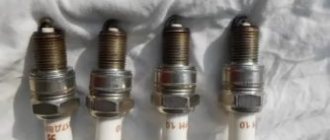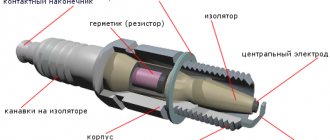Almost every car enthusiast has at least once encountered the concept of flooding candles. This is a common problem that regularly occurs on cars of different makes, models and different years of manufacture.
You can cope with pouring candles. Moreover, car owners often do it themselves. But here it is important to first determine why exactly this happens and what kind of working fluid we are talking about.
Yes, candles can be filled with different compositions. This is directly related to how exactly the motorist will get out of the current situation.
What does “fills the candles” mean?
What does the term “drenched candles” mean? To understand this, let's first understand how everything works. A fuel-air mixture is supplied to the chamber of the internal combustion engine, which subsequently ignites. However, nothing like this will happen if the candles are already filled with liquids. That’s when the “lights out the candles” situation arises.
The cause of the problem lies in the flooding of the electrodes of the spark plugs. The more gasoline that gets in, the more difficult it is to ignite. In most cases this is impossible without thorough drying.
Drivers are more likely to encounter this situation during cold weather. In rainy autumn or frosty winter, the battery is heavily loaded. If the device fails, flooding of the candles is guaranteed.
For example, when you try to start a car several times, the spark plugs become even more filled with process fluid.
Pay attention to a number of reasons that indicate that engine oil has come into contact with the spark plugs:
- Reduced oil content in the crankcase;
- The engine does not start immediately;
- Problems with overclocking and power;
- The engine “troits” - one cylinder is inactive;
- Unstable at idle.
The listed points are signs of other problems arising too. Unscrew the spark plugs and inspect them: focus on the electrodes and insulators. You may find burnt oil or other critical aspects of the condition of the part.
Similar signs occur when coolant gets on machine parts. Additional troubles are characterized by a decrease in power and cooling mixture, as a result of which white soot appears on the spark plugs. A clear sign of this problem is white smoke coming from the exhaust pipe.
A method for the budget conscious
The next solution is suitable for thrifty drivers. Flooded candles must be unscrewed and taken to a warm room. Next, you need to heat them to a temperature determined visually by each motorist. It is believed that for the most effective cleaning of traces of the mixture and carbon deposits, the candle should be red-hot. However, not everyone advises doing this, as it damages the ceramic core of the candle. In addition, after exposing the spark plug to too high a temperature, its surface loses its smoothness and requires polishing with sandpaper or sandpaper.
Causes of persistent problems
Process fluid is important in the operation of spark plugs. Let's consider several options that affect car parts in different ways.
Petrol
Three reasons why spark plugs are often filled with gasoline:
- The battery is often discharged in winter than in warmer periods of time. The device capacity is lost. When you try to start the engine, more and more gasoline sprays are observed. It seems to the driver that a spark is about to appear, but instead the situation only gets worse.
- Incorrect carburetor settings can cause big problems. Therefore, it is important to monitor this node from time to time, since the correct setting periodically fails. The cylinders are overfilled with fuel, which they do not have time to process. Such difficulties rarely arise in summer, but more often in winter.
In modern engines, the ECU controls the fuel supply. Reads information from sensors and acts based on the received data. At lower temperatures, fuel consumption increases. Starting and feeding depends on the serviceability of the devices. If something breaks, the candles are filled with the technological mixture.
Oil
A rare and dangerous situation. The cause is serious damage to engine parts. Engine oil passes through the rings or through a valve and ends up inside the cylinders.
The valve guides wear out and play occurs. From the cylinders, oil is directed into the combustion chamber and fills the spark plugs.
When the piston rings wear out, oil leaks into the combustion chamber. The rings finally become unusable when they burst. To find out about the current condition of the parts, check the compression.
Antifreeze
Let's consider the main reasons for flooding of spark plugs with antifreeze:
- The cylinder block overheats, gets damaged or its gasket becomes outdated.
- Geometry problems due to motor overheating. People say: “I lost my head.”
- The appearance of microcracks on the cylinder walls.
Why the car won't start in winter - the main problems
During the cold season, all the problems in the car begin to take their toll. All drivers know the famous Russian saying: “where it’s thin, it breaks.” This is specifically about winter operation of the car. All you have to do is forget about timely maintenance or skip the process of preparing your car for winter, and the operation of the vehicle becomes simply impossible. If your car won't start in winter, there can be quite a few problems.
Sub-zero temperatures are not the best time to travel by car, but we cannot preserve the vehicle in the garage for the entire winter in order to preserve its performance characteristics. And such a long downtime won’t lead to anything good either. So you need to learn how to properly operate a car in the cold season.
Preparing the car for winter - the basic principles of a winter trip
If we talk directly about the function of the engine, the most important process in preparing for winter is to ensure normal oil and fuel filters for the operation of the power unit. You should also check the operation of the fuel supply system and, if necessary, clean the injector or diesel engine nozzles. This will help ensure proper fuel atomization and ensure normal starting of the power unit.
The oil in the engine and gearbox must be either universal (for the middle climatic zone of Russia) or specially for winter. The latter option does not increase the viscosity index even at temperatures below 40 degrees. Also, when preparing your car for winter, do not forget about the following points:
- replacing car filters, including the cabin filter and air element;
- ensuring the normal operation of the windshield wiper blade with a soft rubber band;
- if necessary, install a pre-heater (especially important for a diesel engine);
- normal functioning of the windshield washer system;
- replacing tires with ones that are appropriate for the season and temperature characteristics.
How to solve a problem
First, we determine the cause of the difficulties. Next, we will work out possible problem scenarios when...
Fills with gasoline
We bleed the cylinders for 10 seconds when opening the throttles. The goal is to get a lean mixture. Unscrew, clean and dry the candles. Check for gaps or other damage. We check the battery voltage with a multimeter.
Do not start the engine until the current problem has been resolved. Try this:
- After the third unsuccessful attempt, wait 10 minutes and try again.
- Be sure to charge the battery.
- Install spare spark plugs. Dry the filled parts and inspect the metal for possible damage.
- Start the engine only after the spark plugs have dried and the battery is fully charged.
Fills with oil
Can fill from above and below. When the insulator is flooded, immediately remove the grease with a syringe or paper. The problem is eliminated depending on the situation: the gasket is replaced or hermetically sealed.
With strong oil flows, it is illogical to move further. We fix the problem by replacing the seals, rings or valve guides.
It is wise to replace oil seals when the valve bushings are still in good condition. Because a new part will not change the situation. Then it is more logical to replace the guide bushings. If there is significant wear, the valves are also replaced.
Fills with antifreeze
The cause of this problem is a burnout of the cylinder head gasket and problems with the geometry of the “head”. Therefore, we replace materials and polish the surface.
In case of serious damage to the head, it is recommended to contact specialists from auto repair shops. The workshop staff will quickly restore the shape of the part. For this purpose, service technicians use professional machines.
Flooding when there is a spark and the starter is rotating
Experienced motorists are faced with situations when a spark appears, the starter rotates, but the lower part of the spark plugs is filled with gasoline. Do not be deluded by the presence of a fire, since this event can occur irregularly under pressure and can be lost while the engine is running.
The cause of the event appears to be excessive pressure in the cylinders. It will be possible to identify the event and the factors that motivate it by monitoring the car on a stand that simulates a combustion chamber.
We recommend paying attention to the valve timing, because their failure will be the cause of wet electrodes . In injection internal combustion engines, motorists should check the functionality of the bypass valve located on the fuel rail. If its malfunctions are ruled out, you will need to find out the gasoline pressure in the rail, because the manufacturer regulates this parameter. Sharp fluctuations and going beyond the specified interval (larger/smaller sides) can block the start of the internal combustion engine or stimulate flooding of contacts for spark ignition.
Verdict
More often, difficulties haunt drivers when they use gasoline and have a dead battery. The spark does not ignite, and fuel fills the spark plugs more and more.
It is not recommended to continue driving in this case. There will be extra gasoline consumption and power indicators will decrease.
At the first sign, fix the problem immediately. An experienced driver always has spare spark plugs in the trunk.
Dealing with the consequences
Let's figure out what to do if the candles are flooded. If the motorist is sure that this has happened, then it is worth drying them using one of the selected methods. Most operating instructions for cars with fuel injection systems recommend immediately unscrewing them from the socket with a spark plug wrench.
At the next stage, dry the engine by cranking the starter without spark plugs for about 10 seconds. After drying, we return the spark generators to their sockets and try to start in normal mode.
It is allowed to start the engine with the spark plugs filled with the option of purging the cylinders. In many situations, this option will make it possible to start the power plant without additional removal of parts. Purge of cylinders in injection engines will be carried out by fully pressing the accelerator pedal during startup and cranking the starter for 10 seconds. Next, release the pedal and try to start normally.
It is important to understand that by pressing the gas pedal during purging, the driver opens the throttle valve as much as possible, which stimulates maximum air penetration into the cylinders and ensures drying of wet surfaces.
Even after purging, the engine may not start in some cases. Then you will have to dry the candles by first unscrewing them and cleaning them from carbon deposits in advance. You will need a medium hard brush. To remove moisture, a hair dryer or oven is suitable, after which check the gap between the electrodes.
After such operations, it is worth purchasing a new set of spark plugs, since the service life of the old ones is significantly reduced after calcination. Replacement is usually carried out after 15–25 thousand kilometers, regardless of the external condition . With frequent filling, it is necessary to get rid of the cause that causes it, and not the consequences.
